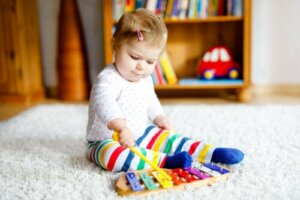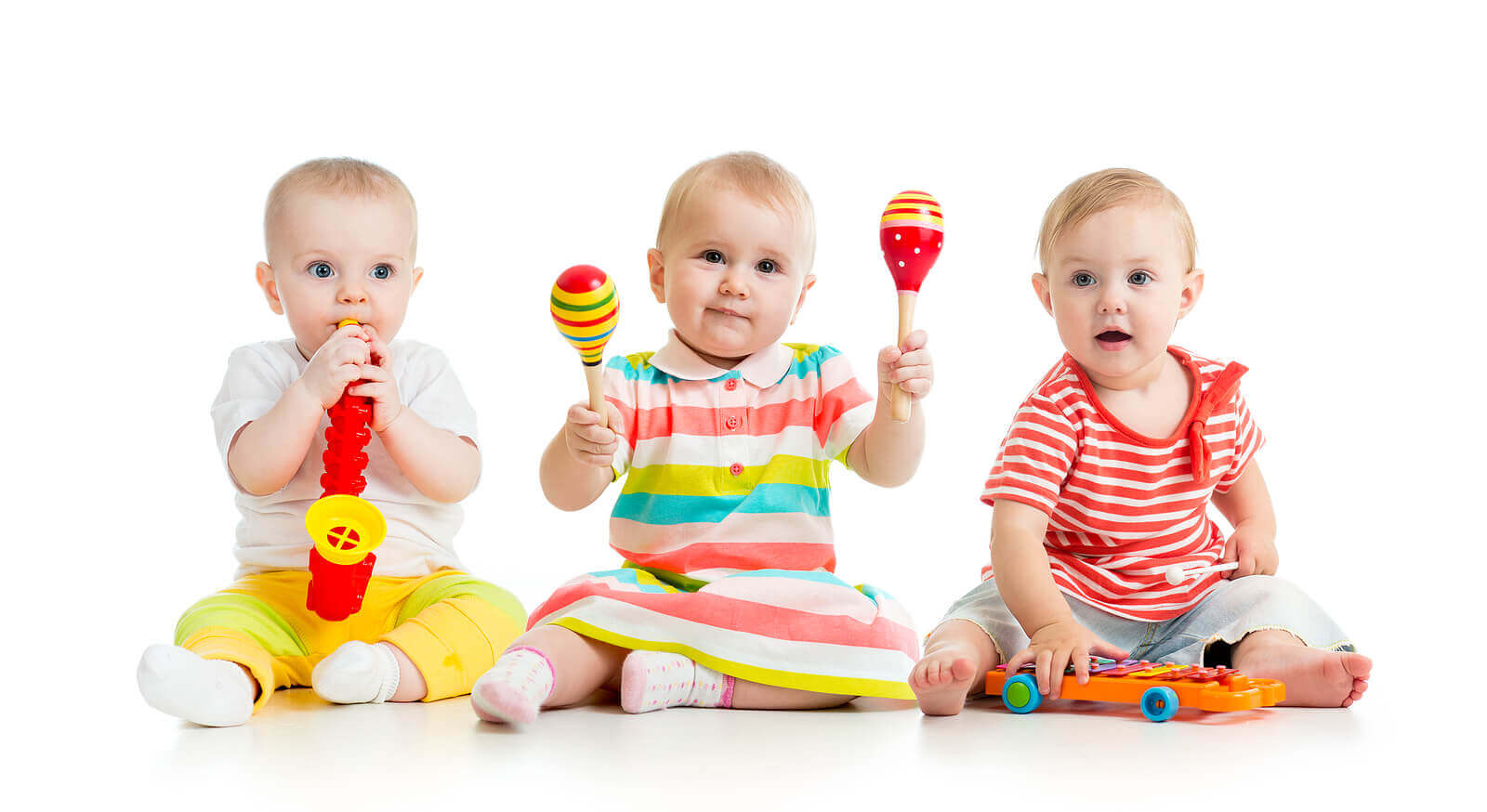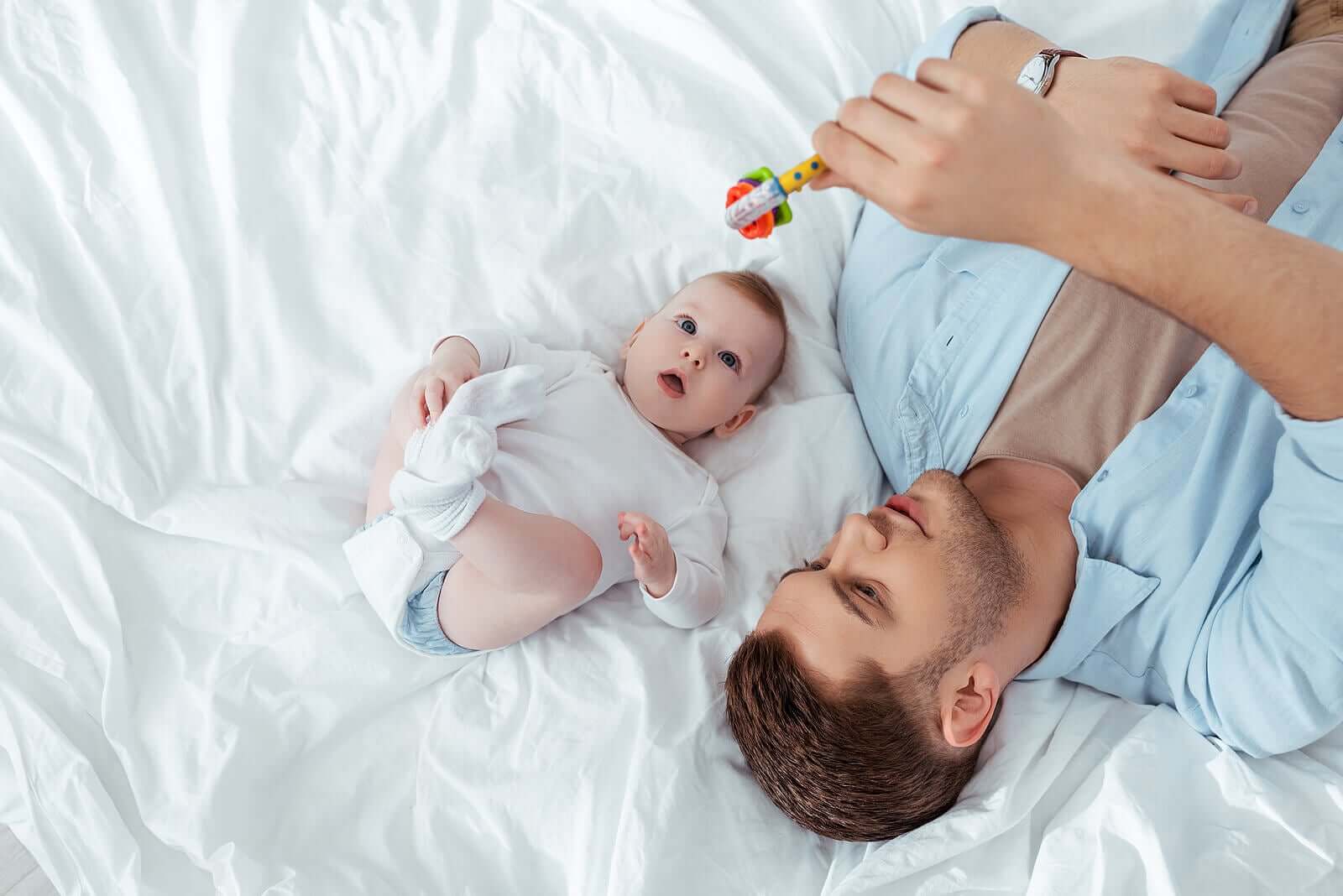The Relationship Between Emotional Bonds and Musical Objects


Written and verified by the psychologist Ana Couñago
According to research, there’s a relationship between emotional bonds and musical objects when it comes to mothers and babies. Why does this occur? We’ll tell you in the article below.
However, before doing so, we need to make an important point. The existence and development of these bonds depend greatly on the communication and type of interaction that occurs between babies and their main caregivers. Specifically, those that occur during a baby’s first months of life.
“The only unbreakable bond on earth is the one between a mother and her baby.”
– Anonymous –
The relationship between emotional bonds and musical objects
Musical objects for babies – maracas, rattles, xylophones, etc. – are a didactic resource commonly used for stimulating their cognitive development. But, today, we also know that they’re ideal for establishing meaningful communicative exchanges between mother and child.

This is precisely what a study at the Autonomous University of Madrid demonstrates. In this study, the researchers analyzed the interactive-musical dynamics between a series of mothers and 2-month-old babies. During their observations, they kept the following three dimensions in mind:
- Rhythmic and metric structure.
- Musical organization.
- Other musical parameters.
The findings of this study
The researchers noted a difference when mothers included some kind of musical object in their interactions with their babies. In these cases, babies responded more actively and paid more attention. Therefore, communication between them was greater and, in turn, their emotional bond became stronger.
The researchers conducted their observations in a familiar, everyday setting. What’s more, they gave mothers only one indication regarding how to use the musical object they received. Therefore, they were able to act freely without the conditioning of external factors.
The research team, in light of these natural observations, affirmed the following:
“The mother communicated with the baby about and through the maraca using a great variety of musical resources. Among those, what stands out is the way the mother built a clear rhythmic and metric structure, which allowed for an increasingly complex musical organization over the course of different sequences. Little by little, the mother added new musical components, restructuring the initial proposals in a new way and alternating interactive resources.”
After these findings, researchers continue to investigate with the intention of broadening their sample base. At the same time, they want to study the appearance of these same behaviors in children between the ages of 0 and 3 years.
The importance of musical objects in the development of babies
Musical objects allow for the creation of a rich and stimulating environment for infant development. This occurs on a sensory, motor, and communication level.

From the time children are very small, they learn to relate and respond to musical toys. Therefore, just as the above study confirms, these objects can be very helpful for mothers. That’s because they serve as a tool to support the communication that mothers try to establish with their newborns.
And this can have a positive impact on the creation of strong, healthy emotional bonds… Bonds that are fundamental to a child’s overall development.
“We can live without religion and meditation, but we cannot survive without human affection.”
– Dalai Lama –
In short, according to current research, we can conclude that there’s a positive relationship between emotional bonds and musical objects. Therefore, why not take advantage of these objects and use them often while interacting with your baby?
The next time you’re about to communicate with your baby, grab a rattle or some other toy that makes noise. Use it to connect with your little one, knowing that it will allow you to share a deeper bond and understand one another better.
According to research, there’s a relationship between emotional bonds and musical objects when it comes to mothers and babies. Why does this occur? We’ll tell you in the article below.
However, before doing so, we need to make an important point. The existence and development of these bonds depend greatly on the communication and type of interaction that occurs between babies and their main caregivers. Specifically, those that occur during a baby’s first months of life.
“The only unbreakable bond on earth is the one between a mother and her baby.”
– Anonymous –
The relationship between emotional bonds and musical objects
Musical objects for babies – maracas, rattles, xylophones, etc. – are a didactic resource commonly used for stimulating their cognitive development. But, today, we also know that they’re ideal for establishing meaningful communicative exchanges between mother and child.

This is precisely what a study at the Autonomous University of Madrid demonstrates. In this study, the researchers analyzed the interactive-musical dynamics between a series of mothers and 2-month-old babies. During their observations, they kept the following three dimensions in mind:
- Rhythmic and metric structure.
- Musical organization.
- Other musical parameters.
The findings of this study
The researchers noted a difference when mothers included some kind of musical object in their interactions with their babies. In these cases, babies responded more actively and paid more attention. Therefore, communication between them was greater and, in turn, their emotional bond became stronger.
The researchers conducted their observations in a familiar, everyday setting. What’s more, they gave mothers only one indication regarding how to use the musical object they received. Therefore, they were able to act freely without the conditioning of external factors.
The research team, in light of these natural observations, affirmed the following:
“The mother communicated with the baby about and through the maraca using a great variety of musical resources. Among those, what stands out is the way the mother built a clear rhythmic and metric structure, which allowed for an increasingly complex musical organization over the course of different sequences. Little by little, the mother added new musical components, restructuring the initial proposals in a new way and alternating interactive resources.”
After these findings, researchers continue to investigate with the intention of broadening their sample base. At the same time, they want to study the appearance of these same behaviors in children between the ages of 0 and 3 years.
The importance of musical objects in the development of babies
Musical objects allow for the creation of a rich and stimulating environment for infant development. This occurs on a sensory, motor, and communication level.

From the time children are very small, they learn to relate and respond to musical toys. Therefore, just as the above study confirms, these objects can be very helpful for mothers. That’s because they serve as a tool to support the communication that mothers try to establish with their newborns.
And this can have a positive impact on the creation of strong, healthy emotional bonds… Bonds that are fundamental to a child’s overall development.
“We can live without religion and meditation, but we cannot survive without human affection.”
– Dalai Lama –
In short, according to current research, we can conclude that there’s a positive relationship between emotional bonds and musical objects. Therefore, why not take advantage of these objects and use them often while interacting with your baby?
The next time you’re about to communicate with your baby, grab a rattle or some other toy that makes noise. Use it to connect with your little one, knowing that it will allow you to share a deeper bond and understand one another better.
All cited sources were thoroughly reviewed by our team to ensure their quality, reliability, currency, and validity. The bibliography of this article was considered reliable and of academic or scientific accuracy.
- Alessandroni, N., Moreno-Núñez, A., Rodríguez, C., & Del Olmo, M. J. (2019). Musical dynamics in early triadic interactions: a case study. Psychological Research, 1-17. https://link.springer.com/article/10.1007/s00426-019-01168-4
This text is provided for informational purposes only and does not replace consultation with a professional. If in doubt, consult your specialist.








